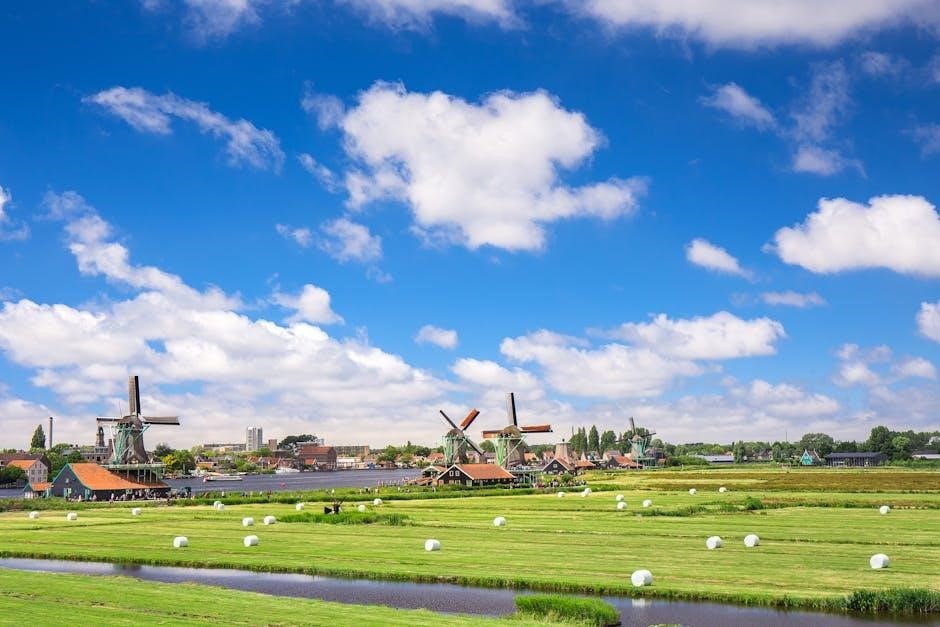The COSA Drainage Manual serves as a comprehensive guide for effective stormwater management in San Antonio․ It provides standardized procedures and design criteria for drainage systems, ensuring compliance with city codes and environmental regulations․ This manual is essential for engineers, contractors, and property owners, offering expert solutions for installation, maintenance, and troubleshooting drainage issues․
1․1 Purpose and Scope of the Manual
The COSA Drainage Manual provides standardized criteria for designing and managing stormwater drainage systems in San Antonio․ Its purpose is to ensure effective drainage solutions while complying with city codes and environmental regulations․ The manual covers planning, design, construction, and maintenance of drainage facilities, offering technical guidance and best practices․ It serves as a resource for engineers, contractors, and property owners, addressing hydrological considerations, runoff analysis, and low-impact development strategies․ The scope includes both urban and watershed management, promoting sustainable drainage practices․
1․2 Key Objectives for Drainage Design
The COSA Drainage Manual emphasizes key objectives for drainage design, focusing on safety, environmental protection, and efficiency․ These include ensuring public safety by preventing erosion and flooding, protecting water quality, and managing stormwater runoff effectively․ Designs must comply with local regulations and integrate with urban planning․ The manual also prioritizes minimizing environmental impacts while maintaining aesthetic and functional standards․ These objectives guide engineers and planners in creating sustainable and resilient drainage systems that meet current and future community needs․

Technical Criteria for Stormwater Drainage
This section outlines the technical criteria for stormwater drainage, including hydraulic capacity, flow velocity, and compliance with local regulations to ensure efficient and sustainable drainage systems․
2․1 Design Principles for Stormwater Management
This section covers fundamental principles for designing effective stormwater management systems․ It emphasizes hydrology, topography, and environmental considerations to ensure systems are efficient and sustainable․ Key elements include watershed analysis, runoff control, and integration with land use planning․ The principles also stress the importance of balancing urban development with ecological preservation, ensuring minimal environmental impact․ Modern techniques like green infrastructure and detention systems are highlighted to maintain water quality and prevent erosion․
2․2 Hydrological Considerations
Hydrological considerations are critical for effective stormwater drainage design․ They involve understanding precipitation patterns, runoff generation, and water flow dynamics․ Factors such as soil type, land use, and topography influence runoff rates and volumes․ Accurate hydrological modeling ensures systems can handle extreme events without causing erosion or flooding․ Additionally, water quality assessments are essential to mitigate pollutant transport․ These considerations guide the selection of appropriate drainage strategies and ensure systems align with environmental and community needs while maintaining ecological balance․ Proper hydrological analysis is vital for long-term system performance and sustainability․
Hydrology and Runoff Analysis
Hydrology and runoff analysis are fundamental to understanding water movement and drainage systems․ These processes evaluate precipitation, infiltration, and runoff to design efficient stormwater management solutions․
3․1 Precipitation and Hydrologic Cycle
Precipitation is the primary driver of the hydrologic cycle, influencing stormwater drainage systems․ It includes rain, snow, and sleet, varying spatially and temporally․ The hydrologic cycle involves evaporation, condensation, and infiltration, shaping runoff patterns․ Understanding precipitation intensity, duration, and frequency is crucial for drainage design․ Infiltration reduces runoff by percolating into soil, while excess water flows overland or through channels․ Accurate precipitation data and hydrologic cycle analysis ensure effective runoff predictions and robust drainage system planning․
3․2 Runoff Coefficients and Calculations
Runoff coefficients are essential for determining stormwater drainage design․ They represent the proportion of rainfall that becomes runoff, varying based on land cover and imperviousness․ Calculations involve multiplying rainfall intensity by the coefficient and drainage area․ Accurate coefficient selection ensures proper system sizing․ Factors like soil type, slope, and vegetation influence runoff rates․ Detailed calculations help design effective drainage systems, preventing flooding and ensuring water quality․ Proper application of these principles is vital for sustainable urban drainage management and environmental protection․

Drainage Planning and Design Process
The drainage planning and design process involves site analysis, hydrological assessments, and integration with Low Impact Development strategies․ It ensures systems are functional, sustainable, and compliant with regulations․
4․1 Site Analysis and Drainage Requirements
Site analysis is critical for identifying drainage needs, leveraging topography, soil types, and existing infrastructure․ Hydrological factors like rainfall intensity and runoff patterns are assessed to determine design parameters․ Regulatory requirements and environmental constraints are evaluated to ensure compliance․ This step involves mapping water flow paths and identifying areas prone to flooding or erosion․ Data collection informs the development of a tailored drainage plan, ensuring systems are functional, sustainable, and aligned with local guidelines․
4․2 Stormwater Diversion and Management
Stormwater diversion involves redirecting runoff to control flow rates and prevent overload on drainage systems․ Techniques include diversion channels, detention ponds, and infiltration basins․ Proper management ensures water quality by filtering pollutants and sediments․ Green infrastructure, such as bioswales, enhances biodiversity while managing runoff․ Regular maintenance of diversion structures is essential to prevent clogging and ensure efficiency․ These strategies minimize erosion, reduce flooding risks, and protect downstream ecosystems, aligning with environmental regulations and community safety standards․
Low Impact Development (LID) Strategies
Low Impact Development (LID) strategies focus on managing stormwater through sustainable practices, reducing runoff, and enhancing water quality․ Key methods include green infrastructure, permeable surfaces, and infiltration systems, promoting environmental stewardship and community resilience․
5․1 Integration of LID into Drainage Systems
Integrating Low Impact Development (LID) into drainage systems involves incorporating green infrastructure and sustainable practices to manage stormwater effectively․ This approach reduces runoff by promoting infiltration, filtration, and evapotranspiration․ LID techniques, such as rain gardens, permeable pavements, and bioswales, can be retrofitted into existing drainage systems or designed into new developments․ Proper planning and collaboration among stakeholders are essential to ensure successful implementation․ This integration enhances water quality, mitigates flooding, and supports environmental goals while maintaining drainage efficiency and community resilience․
5․2 Benefits of LID for Stormwater Management
Low Impact Development (LID) offers numerous benefits for stormwater management, including reduced runoff and peak flow rates․ It improves water quality by filtering pollutants and sediments, enhancing aquatic habitats․ LID also reduces the burden on traditional drainage systems, lowering infrastructure costs and maintenance needs․ Additionally, it promotes groundwater recharge and helps mitigate urban heat islands․ By integrating natural processes, LID supports biodiversity and provides aesthetic and recreational value to communities․ These benefits align with sustainable development goals, making LID a valuable approach for modern stormwater management․

Design Criteria for Drainage Systems
The design criteria ensure functionality, safety, and environmental compliance, outlining standards for hydraulics, materials, and system performance to manage stormwater effectively․
6․1 Storm Sewer Design and Sizing
Storm sewer design involves calculating pipe sizes and layouts to manage runoff efficiently․ Factors include rainfall intensity, drainage area, and allowable flow velocities․ The design ensures pipes can handle peak flows without erosion or surcharging․ Materials selection and hydraulic gradients are critical for system performance and longevity․ Proper sizing balances cost, capacity, and environmental impact, ensuring safe and reliable stormwater conveyance․
6․2 Culvert Design and Hydraulic Capacity
Culvert design focuses on ensuring adequate hydraulic capacity to handle stormwater flows․ Key factors include inlet/outlet conditions, headwater depth, and flow rates․ Proper sizing prevents erosion and ensures safe passage of water․ Materials selection and alignment with natural drainage patterns are critical․ Hydraulic calculations, such as Manning’s equation, help determine required diameters and slopes․ Regular inspection and maintenance are essential to sustain performance and prevent clogging or structural failure over time․

Construction and Maintenance Guidelines
Construction and maintenance guidelines ensure proper installation and upkeep of drainage systems, adhering to design specifications, material standards, and safety protocols to maintain functionality and longevity․
7․1 Installation Best Practices
Proper installation ensures drainage systems function effectively and last longer․ Use approved materials, follow design plans, and verify trench depths and slopes․ Ensure pipes are laid correctly, joints are sealed tightly, and backfilling is done systematically․ Conduct pressure tests post-installation to detect leaks․ Maintain safety protocols, document the process, and ensure compliance with local regulations and environmental standards․ Regular inspections during installation help prevent future issues and guarantee system performance․
7․2 Maintenance Requirements for Drainage Systems
Regular inspections and cleaning of drainage systems are crucial for preventing blockages and ensuring optimal performance․ Inspect pipes, culverts, and catch basins for any signs of damage or debris accumulation․ Schedule routine maintenance activities based on the system’s usage and local environmental conditions to help extend its lifespan․ Address any identified issues promptly to avoid the need for costly repairs in the future․ Additionally, maintain detailed records of all maintenance activities for compliance purposes and to aid in future planning․

Legal and Regulatory Framework
Compliance with local, state, and federal regulations is essential for drainage projects․ Ensure adherence to environmental laws, permits, and zoning requirements to avoid legal complications and penalties․
8․1 Drainage Policies and Ordinances
Drainage policies and ordinances establish legal standards for stormwater management․ Municipalities enforce regulations to ensure systems meet safety, environmental, and infrastructure requirements․ These policies often include permits, inspections, and penalties for non-compliance․ Key components address stormwater runoff, erosion control, and water quality protection․ Local governments update ordinances to align with evolving environmental standards and community needs․ Adherence to these rules is critical for sustainable drainage practices and legal compliance․ Proper enforcement ensures long-term functionality and environmental integrity of drainage systems․
8․2 Compliance with Environmental Standards
Compliance with environmental standards ensures drainage systems protect water quality and ecosystems․ Regulations mandate measures to reduce pollution, prevent erosion, and manage runoff effectively․ Adherence to these standards requires integrating best management practices (BMPs) into designs․ Non-compliance can lead to environmental harm and legal penalties․ Regular monitoring and reporting are essential to maintain compliance․ Updates to standards often reflect advances in technology and environmental science, ensuring sustainable drainage solutions that align with ecological preservation goals and community well-being․
Regional Drainage Master Plan
The Regional Drainage Master Plan ensures effective stormwater management, promoting sustainable practices and coordination among stakeholders․ It provides a framework for future growth while balancing environmental and infrastructure needs․
9․1 Watershed Management Strategies
Watershed management strategies focus on assessing and improving drainage at a regional scale, ensuring sustainable water resource management․ These strategies involve identifying areas prone to flooding, erosion, or water quality issues․ They integrate land-use planning, conservation practices, and infrastructure upgrades to mitigate risks․ Collaboration with local stakeholders, including municipalities and landowners, is essential for success․ Advanced tools like GIS mapping and hydrological models are used to analyze watershed conditions and develop targeted solutions․ The goal is to balance development with environmental protection, ensuring long-term watershed health and resilience․
9․2 Coordination with Local Authorities
Effective coordination with local authorities is crucial for implementing watershed management strategies․ This involves collaboration between regional planners, municipal governments, and stakeholders to ensure drainage systems align with local regulations and community needs․ Regular communication and data sharing are essential to address specific challenges and optimize resource allocation․ Local authorities provide valuable insights into site conditions and community priorities, ensuring that drainage solutions are both practical and sustainable․ This partnership enhances the overall efficiency and acceptance of watershed management initiatives․

Case Studies and Examples
Real-world applications of COSA drainage principles are highlighted through case studies, showcasing successful projects and lessons learned to improve future drainage system designs and implementations effectively․
10․1 Successful Drainage Projects in San Antonio
The COSA drainage manual highlights several successful projects in San Antonio, such as the San Antonio River Improvements and the Alamo City Stormwater Parks․ These initiatives demonstrate effective stormwater management through green infrastructure and innovative design․ By integrating flood mitigation with urban revitalization, these projects have significantly improved water quality, reduced flooding risks, and enhanced community spaces․ They serve as best-practice examples, showcasing collaboration between local authorities, engineers, and stakeholders to achieve sustainable drainage solutions․
10․2 Lessons Learned from Past Implementations
Past drainage projects in San Antonio have revealed key lessons, emphasizing the importance of accurate hydrological data and stakeholder collaboration․ Challenges such as unforeseen site conditions and environmental impacts highlight the need for adaptive management․ Successful projects often integrate green infrastructure and community engagement, ensuring long-term sustainability․ These experiences underscore the value of continuous monitoring and iterative design improvements to address evolving stormwater challenges effectively․

Troubleshooting Common Drainage Issues
Identifying blockages, erosion, and hydraulic inefficiencies early ensures effective drainage system performance․ Regular inspections and maintenance are critical to preventing failures and extending infrastructure lifespan․
11․1 Identifying and Addressing Drainage Problems
Common drainage issues include blockages, erosion, and siltation․ Early detection through visual inspections, CCTV cameras, and flow monitoring helps prevent system failures․ Regular maintenance, such as clearing debris and repairing damaged pipes, is essential․ Advanced tools like drones and sensors can identify problems in real-time․ Addressing issues promptly minimizes environmental impacts and ensures system efficiency․ A proactive approach to drainage management reduces long-term costs and enhances overall performance․ Proper documentation of issues and solutions aids in future planning and optimization․
11․2 Repair and Rehabilitation Techniques
Effective repair and rehabilitation techniques are crucial for maintaining drainage system integrity․ Cured-in-place pipe lining, slip lining, and sectional repairs are common methods․ Epoxy coatings and grout injections are used to seal cracks and joints․ Excavation and replacement are employed for severely damaged pipes․ Regular inspections and timely interventions prevent system failure․ Proper material selection and adherence to design guidelines ensure long-term durability․ These techniques minimize disruption and extend the lifespan of drainage infrastructure, maintaining hydraulic efficiency and reducing future maintenance needs․

Environmental Impact Considerations
Environmental impact considerations focus on minimizing ecological disruption through sustainable drainage practices․ Key strategies include water quality protection, erosion control, and habitat preservation, ensuring compliance with regulations․
12․1 Water Quality and Erosion Control
Water quality and erosion control are critical components of drainage design․ Best management practices (BMPs) such as vegetative buffers, sediment basins, and permeable pavements help mitigate runoff pollutants․ Erosion control measures, including geotextiles and riprap, stabilize channels and prevent sedimentation․ Regular monitoring ensures compliance with water quality standards, protecting aquatic habitats and maintaining ecosystem balance; These strategies are essential for sustainable drainage systems that prioritize environmental protection while managing stormwater effectively․
12․2 Mitigating Environmental Impacts
Mitigating environmental impacts involves implementing strategies to reduce drainage systems’ effects on ecosystems․ Environmental assessments identify potential risks, guiding design adjustments․ Green infrastructure, such as wetlands and biofiltration systems, enhances biodiversity․ Protective measures for sensitive habitats ensure minimal disruption․ Compliance with regulations and ongoing monitoring further safeguard the environment․ These practices balance drainage efficiency with ecological preservation, promoting sustainable development and long-term environmental health․

Resources and References
Additional guidelines, case studies, and technical reports provide further insights․ Contact local drainage authorities for expert advice and updated materials․
13․1 Additional Reading and Guidelines
The COSA Drainage Manual recommends consulting the following resources for comprehensive understanding: Stormwater Management Handbook, Urban Drainage Design Manual, and local hydrology reports․ These documents provide detailed methodologies, case studies, and best practices for effective drainage system planning․ Additionally, refer to the ASCE Manual of Practice and EPA guidelines for water quality standards․ These resources ensure adherence to current engineering practices and regulatory requirements, offering practical solutions for drainage professionals․
13․2 Contact Information for Further Assistance
For further assistance with the COSA Drainage Manual, contact the COSA Engineering Department at (555) 123-4567 or engineering@cosa․gov․ Visit https://www․cosa․gov/drainage for additional resources and forms․ Inquiries are typically responded to within 24-48 hours․ For urgent matters, please call during business hours (Monday-Friday, 8 AM-5 PM)․
The COSA Drainage Manual provides a comprehensive guide for effective stormwater management, ensuring sustainable and resilient drainage systems for future generations while balancing functionality and environmental stewardship․
14․1 Summary of Key Takeaways
The COSA Drainage Manual emphasizes sustainable drainage design, integrating hydrologic analysis, LID strategies, and environmental compliance․ It provides practical tools for stormwater management, ensuring systems are resilient, efficient, and adaptable to future challenges․ By balancing technical criteria with ecological considerations, the manual supports stakeholders in creating effective drainage solutions that protect communities and natural resources, while adhering to regulatory standards and promoting long-term sustainability․
14․2 Future Developments in Drainage Management
Future advancements in drainage management will focus on smart technologies, such as real-time monitoring systems and predictive analytics․ Green infrastructure will play a larger role, with expanded use of permeable pavements and biofiltration systems․ Climate change adaptation will drive innovative designs, ensuring resilience against extreme weather events․ Integration of digital tools will enhance collaboration between stakeholders, improving efficiency and sustainability․ These developments will shape the next generation of drainage systems, ensuring they meet evolving environmental and urbanization challenges effectively․
